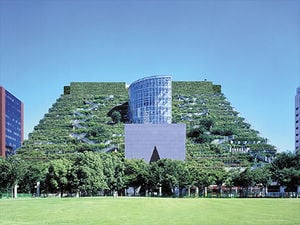
Over half of the world's population already live in urban areas, making sustainable cities a key part of a sustainable planet Earth.
A sustainable city, ecocity or ecopolis is a entire city that is created with the intent to minimize use of energy, water and imported food, and minimize impact from its waste heat, air pollution and water pollution. Richard Register coined the term "ecocity" in his 1987 book, Ecocity Berkeley: building cities for a healthy future. Another leading figure to envisioned the sustainable city was architect Paul F. Downton, who later founded Ecopolis Architects.
What is a sustainable city[edit | edit source]
A sustainable city can feed and power itself with little reliance on the surrounding countryside, and creates the smallest possible ecological footprint for its residents. This is friendly to the surrounding environment, with negligible pollution, low-impact land use, and alleviation of climate change. One effort to try and conceptualise and measure this is the Extended urban metabolism model.
The first thing to consider in how sustainable a city can be is its physical layout. Sprawling means more transport cost, more cost and energy used for infrastructure, and more difficulty in ecological processing of water and wastewater.
Practical achievement[edit | edit source]
These ecological cities are achieved though various means, such as:
- Different agricultural systems such as agricultural plots within the city (suburbs or centre). This, in order to reduce the distance food has to travel from field to fork. Practical work out of this may be done by either small scale/private farming plots or through larger scale agriculture (eg farmscrapers)
- Renewable energy sources, such as wind turbines, solar panels, or bio-gas created from sewage. Cities provide economies of scale that make such energy sources viable.
- Various methods to reduce the need for air conditioning (a massive energy demand), such as low lying buildings that allow air to circulate, natural ventilation systems, an increase in water features, and green spaces equaling at least 20% of the city's surface. This counters the environmental heating caused by factors such as an abundance of tarmac and asphalt, which can heat city areas by up to 6 degrees Celsius during the evening.
- Improved public transport and an increase in pedestrianisation to reduce car emissions. This requires a radically different approach to city planning, with integrated business, industrial, and residential zones. Roads may be designed to make driving difficult.
- Optimal building density to make public transport viable but avoid the creation of urban heat islands.
- Solutions to decrease urban sprawl, by seeking new ways of to allow people to live closer to the workspace.[verification needed] Since the workplace tends to be in the city, downtown, or urban center, they are seeking a way to increase density by changing the antiquated attitudes many suburbanites have towards inner-city areas.[verification needed] One of the new ways is on how this is achieved is by solutions worked out by the Smart Growth Movement.[verification needed]
- green roofs
- green transport
- sustainable urban drainage systems or SUDS
- energy conservation systems/devices
- xeriscaping - garden and landscape design for water conservation
Present and planned sustainable cities[edit | edit source]
Present Eco-cities[edit | edit source]
Planned Eco-cities[edit | edit source]
- Dongtan, China
- Guangdon, China
- Sanya, China[3]
- 3 more to be determined eco-cities planned by Arup in China[4]
- Stockholm, Sweden[5]
- Whyalla, Australia[6]
- Sydney White Bay, Australia[7]
Today, still few real life examples of sustainable cities exist. On a small scale, green buildings such as the Melbourne city council building in Australia produce much of their own energy supplies. Many shanty towns in the underdeveloped world already practice the principles of an ecopolis: efficient power use, recycling, private agriculture, and pedestrianisation. The planned development of Sociópolis in Valencia,W Spain will provide low-rise affordable housing integrated into traditional agricultural zones and irrigation systems. Perhaps the most ambitious project is a planned extension in the Chongming district of Shanghai, referred to as Dongtan. Dongtan is being designed with the specific aim of minimizing the eco-footprint of its residents, and includes plans to become self-sufficient in energy and water production.
Population density and Green Manhattan[edit | edit source]
The article Green Manhattan argues that densely packed city dwellers have a smaller footprint than those in leafier, more natural looking settings. Population density actually facilitates sustainable design in housing and transport. With their apartments backing against each other (great insulation), nowhere to park a car (trains, buses and feet can work well in a dense city) and using elevators as a regular form of transport, their daily energy use is greatly reduced.
Green urban design[edit | edit source]
Certain movements in urban design, or urban planning, recognize the role of density, and value of development nodes around transport hubs. In particular, transit-oriented development (or the very similar concepts of New Urbanism a.k.a. Traditional Neighborhood Design) turn many standard practices of car-centered urban planning on their head.
Transport[edit | edit source]
While the individual chooses what mode of transport to use, the design of the city and the policies of the government have a huge impact on how commuters choose to travel.
Public transport, cycling and usage is enhanced by:
- Walkable environments (density, to reduce distance, and pleasant leafy streets with an even line of building fronts near the street). A good coverage of public transport stops helps.
- Adequate investment - recognizing the many benefits to the community, in air quality, health, reduced congestion, and reduced stress levels.
- Efficient entry, exit and transfers. Poorly designed systems lead to delays and fiddling with tickets, which is tiring for commuters.
Municipal water and sanitation[edit | edit source]

Larger scale and community measures on water include:
- Stormwater management through green space, and permeable pavements, as well as green roofs. See Reducing runoff.
- Treatment and reuse of greywater and even blackwater - this raises important health issues, however and caution should be taken.
Green city government[edit | edit source]
Some city governments have developed a name for their green policies. For example:
- Portland, Oregon, which makes green house designs available to their residents (and encourages their use through cheaper, expedited approval.
- Cities which ban the burning of rubbish (which has already been done in most Western cities[verification needed]) have cleaner air.
In general the adoption of policies to create incentives for sustainable behavior is an effective way to create a sustainable city.
Green coated grey policies[edit | edit source]
Policies restricting density, especially where based on arbitrary measures of floor space to land area, do not encourage good design, and on the contrary encourage waste of space, through roads and landscaping (arguably decorative but not usable). Resisting change, perhaps due to NIMBYism, encourages growth in the same unsustainable patterns that threaten us with climate change and dropping quality of life.
Ecocities[edit | edit source]
Attempts to build sustainable cities from the ground up, i.e. Ecocities, have been made, for example Bahía de Caráquez. On a smaller level, Ecovillages are a similar idea, while Transition Towns aims to transform existing communities.
Personal choices[edit | edit source]
There are many individual choices to make as well, to be a green city dweller - see Sustainable city living.
Notes and references[edit | edit source]
See also[edit | edit source]
- Earthships, together with its company BioTincture, is examining a different route to be used for the developing world (other than developed world) for creating sustainable cities.
- Ekistics
- Megacity
- Metropolis
- Zero energy building
- Sustainable landscape architecture
- Green design
- Ecovillage
- Carfree Cities
- Vianova
- Arcology
- Urban Renewal
- Dongtan
External links[edit | edit source]
- Wikipedia:Eco-cities, Sustainable city
- Ecocity Summit 2008, April 22-26, San Francisco, California.
- Ecocity Builders founded by Richard Register.
- Which way China?Herbert Girardet, 2006 October 2nd, chinadialogue. Discusses the emergences of ecocities in China.
- eco-friendly homes gaining popularity in india
- Los Angeles: A History of the Future
- Zonneterp-project (eco-neighbourhood)
- Sustainable cities information
- Transition Towns, a organisation building sustainable cities
- A proposal for a clean-slate city-state.
- Pearce, Fred. "Ecopolis Now". New Scientist Magazine. 17 June 2006. [http://www.newscientist.com/channel/earth/mg19025561.600-ecocities-special-ecopolis-now.html (subscription required)
- Paul Downton: Ecopolis Now
- Sociopolis Master Plan (2005-2007) [2]
- Arup: Dongtan Eco-city, Shanghai, China
- Register, Richard. Ecocities: Rebuilding cities in balance with nature. New Society Publishers, Gabriola, BC. 2006.
- urb.im, for just and inclusive cities.